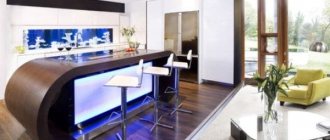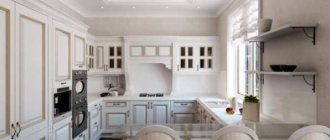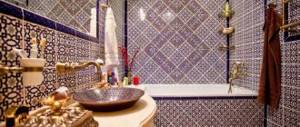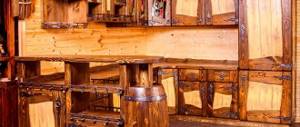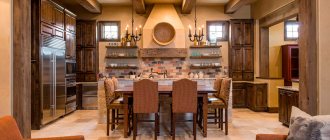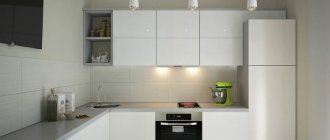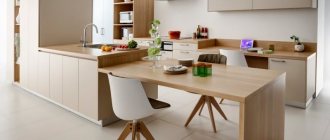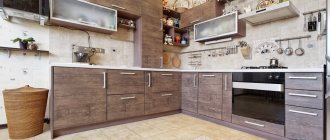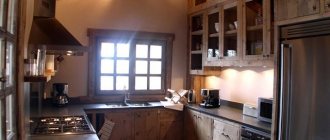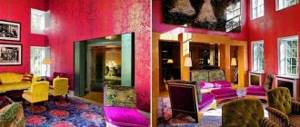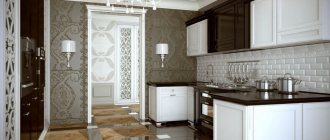The emergence and popularity of eco style is quite natural. The crazy pace of modern life, terrible ecology and pollution, rare trips to nature - all this contributes to the creation of a living, green corner at home.
Adherents of “eco” claim that using this style in your home, you can get a cozy natural oasis that allows you to relax and get a lot of positive things. If you still don’t quite understand what an eco-style kitchen should look like, the photos below will allow you to fully imagine it.
Main features
So, if you decide to create an eco-style kitchen, you must adhere to the key rules:
- Maximum free space. The room should not be cluttered.
- Abundance of light. The room should be very bright. To achieve this, natural and artificial lighting can be used.
- Exclusively natural, environmentally friendly materials. Natural wood, stone, clay, glass, metal, cotton, linen textiles and wool are welcome.
- Natural color scheme. When choosing a color palette, give preference to natural shades: cream, sand, white, as well as sky, water, wood and green vegetation.
- Minimum harm to the environment. This applies not only to the coatings and materials used, but also to the kitchen appliances you choose.
- There is an abundance of living plants in the interior, as well as accessories made from natural materials, be it stone, wood, clay, ceramics, dried flowers, etc.
Color solutions for an eco-style kitchen
Eco-style implies the use of the most natural, natural colors. The standard options, which are the most popular, are the basic shades - beige, brown, white, light gray.
Soft light shades will make the interior light and airy, and the beauty of natural textures will be more noticeable
Green color must be present, at least in small splashes in the form of indoor plants
Typical combination: light gray floor, white walls, natural wood color and exposed brickwork
White color will visually enlarge the space and does not require the owner of the room or the designer to radically develop color solutions: white goes with everything. Both for the base and as accents or decorative elements, both delicate shades and rich colors are used, which echo the colors found in nature. Sand, all shades of brown, rich yellow, green, blue - an ideal choice for a kitchen combined with a living room, or a studio in an eco-loft style. At the same time, acidic colors, black, purple, bright red are not the best choice for interior design in eco-style.
Furniture and colors
When ordering furniture, give preference to solid wood. If this option turns out to be very expensive for you, make only the facades wooden, and the frame from chipboard or MDF.
Important: do not forget that wood can become deformed from exposure to water, and each type of wood has its own requirements for humidity levels. Therefore, it is better that all working surfaces are made of stone. However, a moisture regulator also solves this problem.
The use of plastic or other synthetic elements in this style is undesirable, as they will disrupt the created harmony. If this is not important for you, use skillfully made and practically indistinguishable substitutes; fortunately, there are plenty of them on the modern market.
Glass goes well with wood, so you can safely include it in your interior. It will give the room lightness and airiness, and will also help to visually expand the space.
You can safely choose a glass table for yourself and add other decorative elements made from this material to the room. The apron can be laid out with ceramic tiles that look untreated or with a hog, for example.
Cover the floor with stone or laminate, the texture and color of which is as close as possible to natural wood. Wooden cuts are also suitable for decorating the floor. Considering the high humidity of the room, it would be appropriate to use ceramic floor tiles imitating stone or wood.
There can be a cow or sheep skin on the floor - of course, if this does not contradict your beliefs. And don't worry, the photo you see is a substitute, not the skin of a real animal.
Eco-style involves not only natural shades, but also strict, laconic forms, for which it is also called eco-minimalism. Pretentiousness, carving and other similar elements are excluded.
If you decide to place a soft corner in the kitchen or put cushions on wooden chairs, opt for options with linen or other natural upholstery. Feel free to choose wicker furniture made of rattan or wicker.
Tables and stools made from solid cuts of a trunk or elements of branches will look original. An eco-style kitchen, as seen in the photo, looks advantageous with countertops made of marble and stone.
If we talk about window decoration, the best solution would be light curtains for the kitchen made of cotton, linen, silk and even light wool or blinds made of natural materials, such as wood or bamboo.
Environmentally friendly household appliances are a fundamental requirement ↑
The finishing touch is the choice of household appliances, which are often blamed for exacerbating humanity’s environmental problems. There are two main approaches to the technical equipment of an eco-style kitchen: it is advisable to reduce the number of household appliances to a minimum or an unlimited number of devices should be as close as possible to environmental safety requirements. It is clear that in the age of high technology, few people will use a manual coffee grinder or meat grinder, not to mention other devices that do not have manual analogues, therefore, when choosing kitchen equipment in accordance with eco-style, the main criterion is the safety of the materials from which it is made, high energy saving class.
Eco style is more likely not a style of interior design, but a style of life, way of thinking, attitude towards the world around us, therefore it does not have clearly defined visual characteristics that would distinguish it from other styles in the same way as, for example, Baroque differs from Art Nouveau. This style can combine classic elements with rustic style, blending absolutely harmoniously into a high-tech interior.
Walls and ceiling
The walls in an eco-kitchen can be decorated using the following materials:
- ordinary plaster;
- white or red brick;
- paper wallpaper;
- wooden panels;
- cork covering;
- a natural stone;
- relief ceramic tiles in the form of sand dunes, with shells or stone;
- sea pebbles;
- wood cuts - by the way, you can lay out a drawing from them;
- mosaic.
Modern photo wallpapers on nature themes will bring additional grace and style to the room, giving it individuality and uniqueness.
When finishing the ceiling, you can get by with regular whitewash. Wooden panels or beams are also used, which look great against a light background, plasterboard or textiles. When choosing a material, do not forget about the high humidity and temperature changes inherent in kitchens.
In a private house or attic, a stained glass ceiling with a phyto- or dendro-theme will be a spectacular accent.
Kitchens with eco-veneer facades
Eco-veneer is thin sheets of natural wood. The kitchen facades are lined with veneer on the outside. The appearance of the kitchen set has a wood texture pattern.
Eco-veneer can be used not only to make kitchen furniture, but also to cover walls with panels. Use as a decorative element for decorating partitions.
Bottom cabinets and cases for built-in appliances are made with veneer facades. Upper cabinets can be made of light materials. For a modern small apartment, this combination will visually increase the space.
Similar article: Gray kitchens in a classic style
Lighting
Eco style involves a large amount of natural lighting. Huge floor-to-ceiling windows will be its ideal source. If this is not possible, fill the lack of light artificially.
Kitchen lighting should be soft and warm. Use energy-saving LED or fluorescent lamps that provide diffused, very natural light.
Inconspicuously built-in spotlights above the work surface will provide good lighting when cooking, and the ceiling can be decorated with a decorative lamp or an original chandelier with branches, vines, or, if you wish, horns.
A lampshade made of rice paper, textiles, threads, beads, shells or even clothespins would look good.
Decor
If you can’t imagine your kitchen without decor, then let it be environmentally friendly. You can dry dried flowers, make herbariums and decorate the walls with flat or three-dimensional paintings made with your own hands.
Suitable materials include coffee beans, star anise, seeds, flower petals, moss, pieces of glass and pebbles of round, pleasant shapes. But keep in mind that although your work of art will not emit a pleasant aroma under glass, it will live much longer this way, and it will not accumulate dust.
The walls can be decorated with decorative wicker plates, if you want - with an exotic pattern.
A bread box, napkin holder, coasters for dishes, baskets for vegetables, made in this style, will organically fit into an eco-friendly interior.
Necklaces made of garlic or chili peppers, which also have healing properties, will help revive a modest design. But remember, there should not be many decorative elements, so most likely you will have to limit yourself to a couple of suggested items.
Finishing
This style is not only an external decoration of the room, but also a certain lifestyle with concern for the environment and your health. Only environmentally friendly materials are used. Therefore, when choosing paint, flooring or wallpaper, preference should be given to the safest and most natural materials.
The ceiling can simply be whitewashed. Wooden beams or slats look great. A blue ceiling will remind you of the open sky and will also visually expand the space.
There are many different options for decorating walls in eco-style. The most budget-friendly option is painting or wallpapering. More expensive options include natural stone, clay tiles, bamboo, wooden panels or slats, cork, jute, etc. You can make an accent on the wall in the form of a fragment of sea pebbles, 3D wallpaper with any natural image or natural plants.
For example, walls made of succulents and moss are common in eco-style. It's expensive, but very effective. This panel lasts up to 8 years. It is treated with glycerin, due to which the plants do not require watering and always look fresh.
For the floor, it is best to choose ceramic tiles or stone. Wooden coverings are also used, but they are not very suitable for the kitchen due to their lower strength and moisture resistance. Mat carpets serve as an additional covering. It's practical and environmentally friendly. As needed, they are vacuumed and shaken out. The grass-shaped carpet looks original. In a dining area, a carpet is not the best solution, but this option goes well with other interior elements in a natural style.
Important! When choosing materials for finishing the kitchen, you should remember that this is a room with constantly changing air temperature and humidity. Coatings must withstand all these loads.
